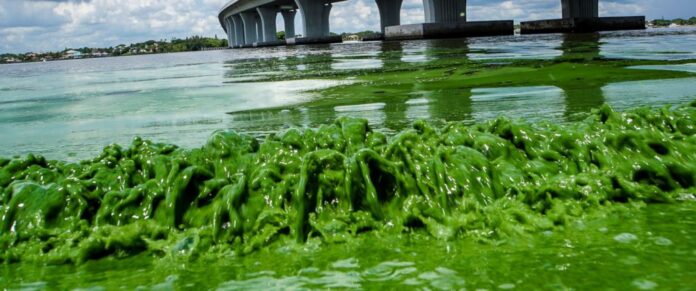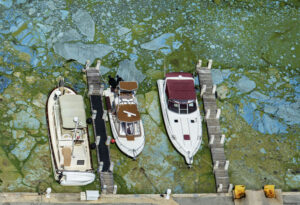In a season that should be thriving with business and beach goers, along Florida’s Treasure Coast, the only thing blooming is blue-green algae. The algae growth has caused some beaches and waterways to be closed.
“The detrimental water conditions are keeping many residents indoors,” says Dustyn Shroff, vice president of GreatFlorida Insurance, Florida’s largest independent healthcare insurance agency. Florida residents have described the algae as; “thick,” “slimy,” “greenish gunk,” smelling, “atrocious,” “worse than the sewer” and “putrid”.
The Florida Department of Environmental Protection (DEP) reports, blue-green algae also known as, “cyanobacteria” typically develops in nutrient-rich lakes that contain high levels of phosphorous and nitrogen. Standard conditions in Florida, such as high temperatures, warm water and ample sunlight provide ideal conditions for the toxic blooms to thrive.
The harmful algae blooms did not occur overnight. The Tampa Bay Times reports that in May, water managers discovered a 33-square mile algae bloom in Lake Okeechobee.
In January, the U.S. Army Corps of Engineers started dumping water from the lake into the St. Lucie Estuary due to flooding from heavy rains. The discharges from Lake Okeechobee, Florida’s largest freshwater lake- also considered heavily toxic, began to flow into surrounding waters including the ocean.
According to samples taken by the DEP, the alga is toxic. The governor has declared a state of emergency twice this year. Affected areas include: Martin, St. Lucie, Lee and Palm Beach counties.
“The toxic nature of the algae blooms can cause serious health problems leaving children and pets vulnerable,” says Buck with GreatFlorida Insurance, Florida’s top independent healthcare insurance agency.
The blue-green algae can cause skin rashes, nausea, respiratory issues, cramps, diarrhea and vomiting. Long term problems include; liver, kidney and nervous system damage. If you leave in the affected counties and begin experiencing unusual symptoms, see a doctor promptly.
Environmental damage includes, killing seagrass, and small animals such as shrimp, crabs and even fish.
To help ease the algae bloom problem, the Army Corps began reducing the flow into the St. Lucie and the Caloosahatchee Estuaries. Officials will continue to monitor the algae’s toxicity levels.
Blooms can last, days, weeks or months depending on conditions. Scientists cannot predict how long the blooms will last. The blooms run their course and dissipate naturally to prevent the spreading of toxins.
You can report algae blooms in your area by calling 1-855-305-3903 or visiting www.reportalgalbloom.com.
GreatFlorida Insurance provides customized and affordable health insurance policies to suit you and your family, contact us today.





